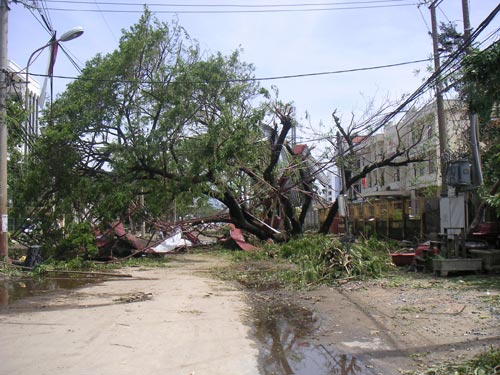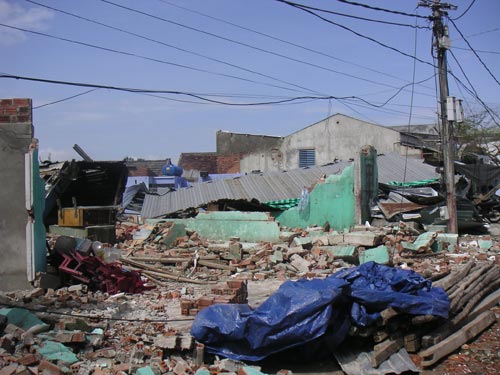View from the perspective of climate change
In the last days of last September, people in the Central - Central Highlands provinces faced a great devastating storm and a terrible flood in history.
According to incomplete statistics, the number 9 storm and the historic flood have claimed more than 163 deaths, 17 missing people, thousands of houses completely collapsed, more than 3 million Vietnamese are affected, estimated damages up to 800 million dollars.
This is a horrifying number, even if only the estimate, if detailed statistics, human and property losses have not stopped at these numbers. This again raises a warning bell about climate change and human codes of conduct with nature.
According to the Minister of Natural Resources and Environment Pham Khoi Nguyen at the Forum on Disaster Mitigation and Climate Change Adaptation held on October 7, 2009, Vietnam is located in the monsoon tropics and directly affected by the storm of Asia - Pacific, one of the five major storms of the world.


Where the storm passes.
Chairing the Conference, Deputy Prime Minister Hoang Trung Hai said, in the last 5 years, in our country, on average, each year natural disasters robbed nearly 400 people, the estimated loss of property from 1 to 1, 5% of GDP. Particularly in the first 9 months of 2009, natural disasters caused 292 deaths and disappearances, and economic losses were estimated at VND 24,000 billion.
' Vietnam will be severely affected by climate change. If the sea level rises by 1m, 90% of the Mekong Delta area will be inundated during the flood season, while the dry season is 71% of the area affected by saline intrusion . '. Our country is one of the 10 countries with the highest frequency of natural disasters in the world. It is well known that the problem of how to adapt to changes with environmental changes, mitigate natural disasters from the perspective of human behavior with the natural environment.
It is not too early if we raise this issue. The losses of floods and storms were too great, especially for farmers in particular and the poor in general. If viewed objectively, the harshness of nature is partly an inevitable consequence of the attitude of treating the environment. Please give a few examples in the localities damaged in the 9th storm.
1. In Da Nang city, in the past the system of casuarina protection forest was planted along the coast to Hoi An. But due to the need to open roads and build resorts and resorts, soon the tens of hectares of forest were wiped out. In Sangsane in 2006 and the last typhoon 9, the consequences of the destruction of coastal protection forests have been seen. These roads are destroyed by ocean waves. The 5-star road turned into a landfill. The design to adapt to actual conditions has not been properly concerned. And Son Tra Dien Ngoc - Cua Dai road is covered with sand up all meters. 5-star resorts are also shattered by stormy winds. The encroachment on the sea and the destruction of the coastal forest ecosystem have shown obvious consequences.
2. In Quang Nam, typhoon 9 is not the biggest storm, and the average rainfall is not the highest. However, the post-storm flood is considered a history. Many localities such as Dai Loc, Tam Ky and Dien Ban . were submerged in floods; The flooding speed has increased rapidly as ever, and the flood peak is much higher than in 1999. Flood receded, life is disturbed, mud is a meter high.
Why is flooding more and more aggressive, is it because of nature's anger? Of course by humans. Quang Nam watershed forest has been silently protecting people for decades of devastation to harvest timber, placer gold mining or deforestation for afforestation and hydropower production. In the south, there are always positive reports that it is possible to stop illegal timber exploitation but it is actually through the storm and storm.

Floods on the Han River
Thousands of cubic meters of timber have been properly exploited floating on Vu Gia River and caught at the foot of Quang Hue Bridge to form a wooden river. Local people have mobilized all means and manpower but still have not exploited this illegal timber river. Also in Da Nang seaport, the wood has sealed the beaches, the forest fortune has been given to humans or the post-nature of nature has come?
3. Kon Tum was mourning during the flood. Soon many villages of Tumarong district were razed. The great flood has been the most devastating thing in the last hundred years. In the face of such great losses, Mr. Ha Ban - Secretary of the provincial Party Committee of Kon Tum province pulled out lessons, but it was still timely: The reason was because the forest was destroyed. To avoid flooding, there is no other way to relocate people to new places to stabilize and minimize the deforestation .
From the above three examples, despite all, people have a rough impact on nature. For the immediate benefit, people invade nature in a large and organized way without thinking about ecological regeneration or balance. As a result, we are facing increasing challenges from nature. No longer a forecast but the consequences have been coming to us.
In order to curb natural disasters and adapt to climate change, we should now take serious evaluations of the consequences of human impact on nature. Thereby there are long-term strategic solutions to solve this global problem.
Natural disasters are always hidden, so adapting to climate change is the top target. Take immediate lessons to educate the next generation to raise awareness of environmental protection. It is time to see natural disasters as an urgent matter; adapting to the environment is a vital issue; Environmental destruction is also a crime that needs to be condemned.
- This is how Dubai copes with climate change
- US President Donald Trump dismissed the view of human-induced climate change
- What is Climate Change?
- Marching for climate change around the world
- The terrifying change of the Earth due to climate change
- All things about love from a scientific perspective
- SimCLIM helps build climate change scenarios
- Climate change is happening faster than expected
- 4 shocking findings on climate change
- Too many animals and plants disappear due to climate change
- How is climate change damaging our health?
- The scary of climate change: The coldest animals cannot live anymore
 Is the magnetic North Pole shift dangerous to humanity?
Is the magnetic North Pole shift dangerous to humanity? Washington legalizes the recycling of human bodies into fertilizer
Washington legalizes the recycling of human bodies into fertilizer Lightning stone - the mysterious guest
Lightning stone - the mysterious guest Stunned by the mysterious sunset, strange appearance
Stunned by the mysterious sunset, strange appearance